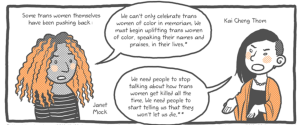“The dishes of America’s recent immigrants have become check marks on a cultural scavenger hunt for society’s elite.” —Ruth Tam
I watch a lot of competitive cooking shows. And it seems like whenever there is a “bizarre” or “exotic” cooking ingredient, it’s associated with foods from my culture and childhood. 100 year old egg. Duck bills. Stinky tofu.
Mainstream media has made a spectacle out of foods from seemingly exotic places.
I’ve also observed a lot of White chefs create “Asian-inspired” dishes. When going out to eat, I notice many “Asian-fusion” themed restaurants where chefs combine all the countries and flavors in the vast and diverse continent of Asia and throw them together on both plate and menu.
What is “Asian inspired” or “Asian-fusion?” I have a sinking suspicion it’s not like when my mom made me sushi with cucumbers, lunch meat, and eggs growing up. Or toast with mayonnaise and pork sung. People used to make fun of the food I eat, and now suddenly, stuff like spam fried rice is selling at a hip new restaurant for $16.
It’s frustrating when my culture gets consumed and appropriated as both trend and tourism.
When it comes to food, what’s appropriation and what’s not can be tricky to think about.
Cultural appropriation is when members of a dominant culture adopt parts of another culture from people that they’ve also systematically oppressed. The dominant culture can try the food and love the food without ever having to experience oppression because of their consumption.
With food, it isn’t just eating food from someone else’s culture. It might not be appropriation if you’re White and you love eating dumplings and hand pulled noodles. Enjoying food from another culture is perfectly fine.
But, food is appropriated when people from the dominant culture – in the case of the US, white folks – start to fetishize or commercialize it, and when they hoard access to that particular food.
When a dominant culture reduces another community to its cuisine, subsumes histories and stories into menu items – when people think culture can seemingly be understood with a bite of food, that’s where it gets problematic.
It’s also harmful when the dominant culture controls the economic and material resources to produce that food for their own consumption and profit.
Here are some dining behaviors that are culturally appropriative when it comes to food.
1. Seeking ‘Authentic’ and ‘Exotic’ ‘Ethnic’ Food
Often, when we talk about “ethnic” food, we’re not referring to French, German, or Italian cuisine, and definitely not those Ikea Swedish meatballs.
Usually, we re talking about Thai, Vietnamese, Indian, Ethiopian, and Mexican food –places where food is cooked by the “brownest” people.
While food from Western Europe is still connected to ethnic roots, ethnic food has become reserved only for ethnicities that are perceived as exotic and foreign to White folks.
While food can connect people together and also serve as a way to learn about cultures other than our own, what happens is that food becomes the only identifier for certain places. Japan reduced to ramen and sushi, Mexico reduced to tacos and burritos, India reduced to curry, and so on.
Entire regions become deduced to menu options and ingredients without any thought to the many different communities in these places. There’s a loss of complexity and cultures end up getting homogenized.
In seeking “authentic” food, we’re hoping for a truly immersive experience into another culture. The food experience, whether in a restaurant in someone’s home city or as part of a trip somewhere else, comes to represent a larger experience with that culture and community. Our perceptions of what is “authentic” stem from pre-conceived “exotic narratives” of that culture and communities.
“Oh, during my trip to Asia, I had the most authentic [fill in the blank].”
Food culture has travelled and flowed in messy and complicated ways across the globe.
The impacts of historical and ongoing colonization are devastating to many cultures, and many “authentic” “ethnic” cuisines are connected to histories of colonization.
For example, what is now Vietnam had been occupied by China for a thousand years and then colonized by France. This period of colonization is also what led to things like banh mi (sandwiches) and banh ex (crepes). The use of spam in different parts of Asia and the Pacific Islands, like spam musubi or spam in hot pot, are a direct result of US colonization.
If you love a dish and think it’s delicious, great! If you’re searching for a place that serves a particular dish, also great!
However, seeking “authenticity” fetishizes the sustenance of another culture. The idea of the “authentic” food experience is separated from reality. It also freezes a culture in a particular place in time.
2. Having Your Friend of Color Be Your Food Expert
Don’t get me wrong, I love sharing foods from my culture with friends. I also love helping friends with restaurant recommendations and spending a long time on Yelp! trying to find good options for a group to go.
Where I take issue is when I become someone’s food ambassador to all of Asia.
Some friends have expected me to know where to get ramen, “real” Chinese food, “street-style” Thai food, Korean BBQ – and they’re disappointed when I don’t know. These are also the friends that once made fun of my food.
As someone who straddles different cultural identities, as Taiwanese and American, my knowledge of my culture comes from my parents and my personal experiences growing up.
My experiences of Taiwanese food are mostly from following my parents around, and because my language skills are rudimentary, I can never find the restaurant we went to or order the same things they did again.
There’s also a lot I don’t know about other Asian cultures, about the complex relationships and power dynamics between Asian countries. There’s a lot that I’m still learning, too. I do my own research on places to check out and you can too.
“What is the most authentic way to eat this?” “Where can I go to find authentic [fill in the blank]?”
Context matters. For example, asking if I’ve found any hand-pulled noodle joints that I like in the area is different than asking if I know authentic hand-pulled noodle joints.
The difference is that what you’re seeking is one person and one place to represent an entire culture for you.
There is no one right way to eat something and no one perfect dish to eat. People from different cultures all have their own food preferences, too – the unique ways their families make something or the way they prepare their own meal. It’d be like me asking, “Hey, what’s the most authentic way to eat a hamburger?”
Don’t constantly treat your friend of color as your food tour guide. We’re happy eating our cultural foods with you, but that’s not what our entire friendship should be about.
3. Wanting Adventure Points for Eating Food
Like early explorers “discovering” spices on their quests for new trade routes, some diners today are on similar quests to “discover” different ingredients and cuisines.
It’s great when people want to try foods they’re not used to or when they’re open to eating different things, but what ends up being problematic is when people want to be rewarded for their bold, adventurous experimentation with another culture. Where people can now literally check in on an app and receive a badge for their food adventures, but others want bonus real life adventure points.
When people think they’re being adventurous for trying food from another culture, it’s the same thing as treating that food as bizarre or weird.
The person outside of the culture becomes the person with “insider” knowledge about this exotic, other culture. The theme of “Westerner as cultural connoisseur” is rooted in imperialist ideas about discovering another culture and then making oneself the main character in the exchange. “I was transformed by my trip to [fill in the blank].”
Some folks want to be applauded for trying chicken feet, fermented bean curd, or just for eating with chopsticks. It’s disconcerting to eat with folks who are going to giggle about ingredients make comments like, “Oh my god, this is so weird! This is gross!” and run back to tell all their other friends about trying it and how “awesome” that experience was.
One of my favorite foods is a Szechuan dish with pig intestine and congealed pigs blood, and my parents get it as take out for whenever I visit home. The thing is, I’m not an “adventurous” eater. The “bizarre and weird” are foods that I’m familiar and comfortable with, food that I grew up eating.
By making a big deal out of someone’s culture and food, it reminds them that they’re culture is abnormal and doesn’t quite belong in this world.
4. Loving the Food, Not the People
When food gets disconnected from the communities and places its from, people can easily start forgetting and ignoring historical and ongoing oppression faced by those communities.
America has corporatized “Middle Eastern food” like hummus and falafel, and some people might live by halal food carts, but not understand or address the ongoing Islamophobia in the US.
Folks might love Mexican food, but not care about different issues such as labor equity and immigration policy that impact members from that community.
There are also really hurtful stereotypes connected to food where people of color get reduced to the food they eat or are called things like smelly because of their food consumption.
Eating food from another culture in isolation from that culture’s history and also current issues mean that we’re just borrowing the pieces that are enjoyable – palatable and easily digestible. We might not know how kung pao chicken also reflects a story about Chinese immigration or the complex colonial story behind curry and the homogenization of South Asian cultures.
5. Profiting from Oppression
More and more now, part of chefs’ culinary training also involves travel in order to learn about different cooking techniques and ingredients, and they’re opening up fancy restaurants that repurpose “cheap” eats from working class and poor communities that rely on affordable, local products and ingredients.
Food culture gets re-colonized by chefs seeking to make that “authentic” street food they tried more elegant. Often, these restaurants are inaccessible to the communities they’re appropriating from.
This is different from when members from that community repurpose their own traditional foods.
One of the questions that both chefs and diners should ask themselves is, who is laboring and profiting? Where are these recipes from?
Who is this cuisine profiting off, but not supporting – a group that is historically and currently oppressed?
Another problem is when ingredients get reappropriated. Corporations have now repackaged local food from different places in ways that make it no longer accessible to the local communities they’re from.
Quinoa, which is native to Bolivia is now too expensive for communities there. Last year, Whole Foods declared collard greens the “new kale.” Coconuts have now been packaged as high end, luxury water. Tofu, soy, and tempeh are now staples at organic, healthy food markets.
This is food gentrification, where communities can no longer afford their own cuisines and sustain their traditions.
***
Food is an important part of communities and cultures – the relationship between food and culture also means that food can be used as a tool of marginalization and oppression.
It’s okay if you love the taco truck outside of your workplace, love eating sushi, or enjoy trying out different recipes at home. I’m not against trying and cooking food outside your own culture – I love it, too.
However, it’s critical for us to reflect on how we perceive the cultures that we’re consuming and think about the relationships between food, people, and power.
Colonization and gentrification are directly related to the appropriation of food. We also need to begin educating ourselves on issues and event that impact the communities that we’re drawing our meals from.
[do_widget id=’text-101′]
Rachel Kuo is a Contributing Writer for Everyday Feminism and a scholar and educator based in New York City. Her professional background is in designing curriculum and also communications strategy for social justice education initiatives. You can follow her on Twitter @rachelkuo.
Search our 3000+ articles!
Read our articles about:
Our online racial justice training
Used by hundreds of universities, non-profits, and businesses.
Click to learn more





















